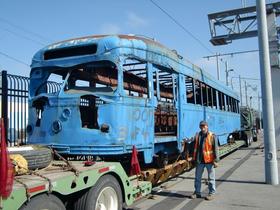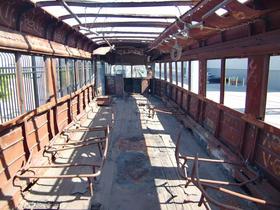The last of Muni’s precious fleet of double-end PCC streamliner streetcars is now on the road, headed for Broookville, Pennsylvania and complete rebuilding under Muni’s contract to bring 16 more fully restored PCCs to San Francisco’s streets.
And boy, does this one need restoration.You could call it the ultimate test.
Quick background: Of the almost 5,000 PCC streetcars manufactured in the U.S. between 1936 and 1952, only about one percent was double-ended: the operator can just switch ends and go back the other way without the need for a track loop. The forthcoming E-line from Caltrain to Fisherman’s Wharf, promised in time for America’s Cup in 2013, needs double-end cars to start up.
Muni bought 10 of these rare double-enders in 1948; eight survived until retirement in the 1980s; one of these is now at a museum in Australia. Of the seven still in Muni hands, three are on the street now, painted in tribute liveries to cities that ran double-end PCCs (Nos. 1007, 1010, and 1015). The remaining four are part of the current contract with Brookville Equipment Company. Nos. . and 1008 went to Brookville first and should return later this year, both painted in their original 1948 Muni green and cream “Wings” livery. No. 1011 followed them east more recently and will return in a tribute livery to our namesake, Market Street Railway, Muni’s private competitor, which dreamed of ordering double-end PCCs but could never afford to. All of these double-enders, including No. 1009 (which will be painted in tribute to Dallas) are being completely rebuilt to like-new condition, but with modern communications capabilities and full accessibility.
No. 1009, shown here, is in by far the worst condition of the group. After retirement, it was stored outdoors on a Bay pier for almost 30 years. Vandals got into it and lit a fire at one point. Parts were stolen at other times. But these rare double-end vehicles are also among the highest capacity PCCs ever built, and thus valuable for E-line service. So, it was included in the bid package. These cars originally had wood and canvas roofs, a carryover from old streetcar practice. This accounts for the “sunroof” you see. When it’s rebuilt, it will have a steel roof, like the ones already restored.
The contract, covering complete rewiring of 11 PCCs and total rebuilding of five others, comes in at more than $18 million, averaging more than $1.1 million per car. By comparison, a new modern streetcar costs considerably more than twice that figure, and a new light rail vehicle (like Muni’s Breda LRVs) about four times as much.
All of the streetcars in the order are expected to be back and operational in time for America’s Cup. The single-end PCCs in the order will allow for increased service on the F-line, while the four double-end PCCs, plus the three already in service, will form the base fleet for the E-line, the tracks, wires, and stations for which are already in place, sharing the southern Embarcadero with N and T line LRVs and the northern Embarcadero with the F-line.


Finally, the “Blue Goose” leaves Metro East. Like the three previously-rebuilt Torpedoes–and the three already at Brookville–it has to come back as a swan!
Is this the last car in the entire Brookville contract to leave?
Judging by the present condition of No. 1009, if its to be running on San Francisco tracks by the Americas Cup, they might have to postpone the races ’til 2014. Regardless, the result is a real testament to the master craftwork of restoration specialists.
If we are desperate for these double enders, I am very curious why we have not contacted Seashore Trolley Museum which has 6 double ended PCCs available on line,,They describe them as operational but needing work,,The picture of one of the cars shows a much cleaner and operational vehicle than the one in our picture,,,I am curious if Market Street Railway or Muni are aware of these 6 PCCs.,,Cary Brotman
The underframes on the Seashore cars, the most important component, are completely rusted through. I inspected these cars myself, more than five years ago, and they were unacceptable then. They can only be more so now.
Well Judging the appearance of 1009. I’m sure new structural frame members can be built and installed on the 6 cars at Seashore. Only thing is those cars are Pullman Standard built cars and 1009 it’s sisters are St. Louis built cars. That would be a great variety though to say the least. So why not?
Bryan
Why not, Bryan? How about money? There isn’t any right now for additional cars, not while the 1050 class and other three Muni PCCs all need significant work after 16 years of even harder-than-expected service. Additionally, those Seashore cars have single rear doors, not desirable given that we’re working to move the F-line toward all-door boarding to speed operations.
I rode all the double ended, “Torpedo Cars”, when they were operational in San Francisco in the late 1950s to 1962. Mostly on the K line going to City College almost daily. They ran great then and I’ve seen the work Brookville can do and I’m sure 1009 will come back in great shape to be a great addition to the E or F line.
To bad that one can not be purchased (or traded) from Australia.
1014 was looking pretty good when I visited the Sydney Tram Museum in Loftus, Australia back in 1993:
http://www.railpictures.net/viewphoto.php?id=50961
Okay, I’ll be the heretic: Looking at the mess this car is in, and how much metal came off of the ones already at Brookville–where cars there were practically stripped bare and built seemingly almost new (see the pictures in previous issues of “On Track”)–how much of this car is actually going to survive as a restoration, and not, in strictly moralist terms, come back an entirely new car?